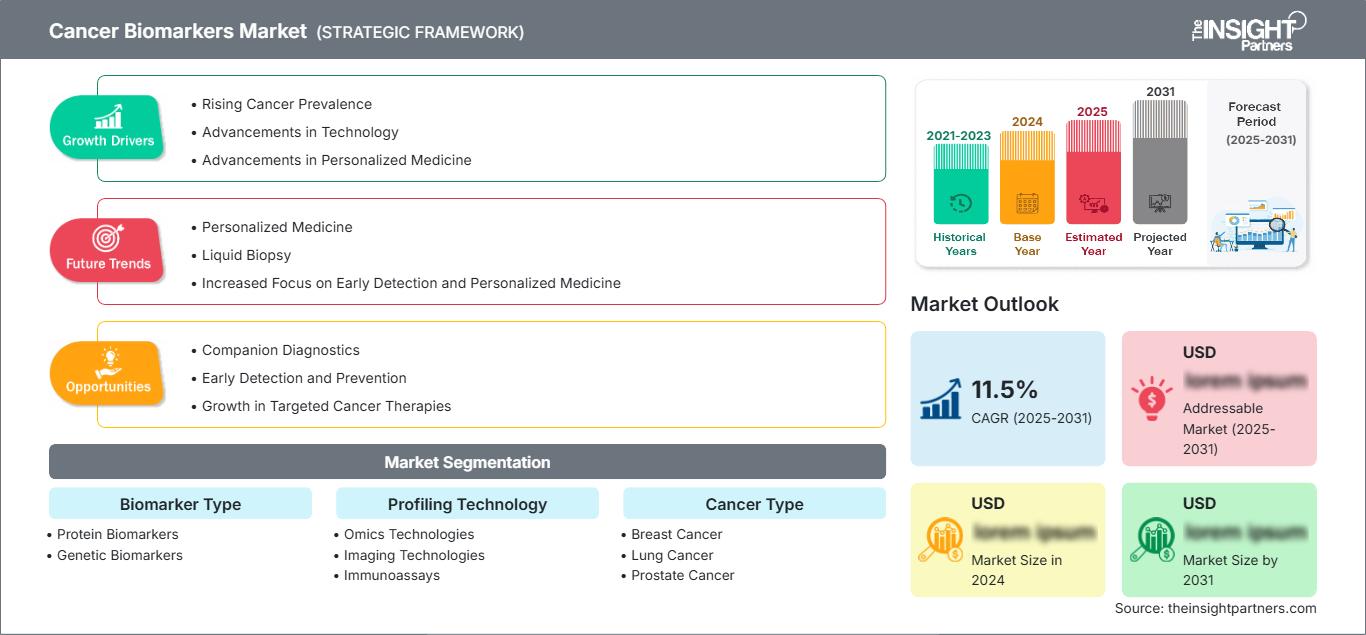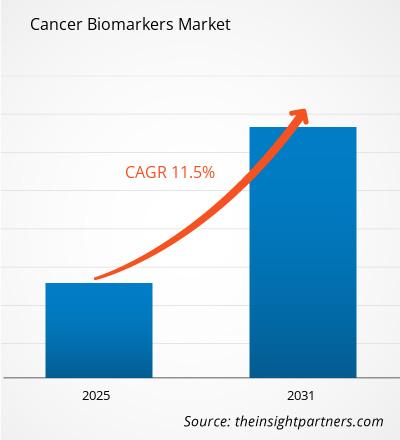Der Markt für Krebsbiomarker wird bis 2031 voraussichtlich ein Volumen von 83,9 Milliarden US-Dollar erreichen. Für den Zeitraum 2025–2031 wird ein jährliches Wachstum von 10,8 % erwartet.
Der Bericht ist segmentiert nach Biomarker-Typ (Protein-Biomarker, Genetische Biomarker), Profiling-Technologie (Omics-Technologien, Bildgebungstechnologien, Immunoassays, Zytogenetik, Bioinformatik), Krebsart (Brustkrebs, Lungenkrebs, Prostatakrebs, Leukämie, Blasenkrebs) und Anwendung (Prognostik, Diagnostik, Forschung und Entwicklung). Die globale Analyse wird zudem auf regionaler Ebene und für wichtige Länder aufgeschlüsselt. Die Marktbewertung für die oben genannte Segmentanalyse wird in US-Dollar dargestellt.
Zweck des Berichts
Der Bericht „Markt für Krebsbiomarker“ von The Insight Partners beschreibt die aktuelle Marktlage und das zukünftige Wachstum sowie die wichtigsten Triebkräfte, Herausforderungen und Chancen. Dies wird verschiedenen Akteuren im Geschäftsbereich Einblicke ermöglichen, wie beispielsweise:
- Technologieanbieter/Hersteller: Um die sich entwickelnde Marktdynamik zu verstehen und potenzielle Wachstumschancen zu erkennen, können sie fundierte strategische Entscheidungen treffen.
- Investoren: Um eine umfassende Trendanalyse hinsichtlich Marktwachstumsrate, Finanzprognosen und Chancen entlang der Wertschöpfungskette durchzuführen.
- Regulierungsbehörden: Um Richtlinien zu regulieren und Aktivitäten auf dem Markt zu überwachen, mit dem Ziel, Missbrauch zu minimieren, das Vertrauen der Anleger zu wahren und die Integrität und Stabilität des Marktes zu gewährleisten. Marktsegmentierung für Krebsbiomarker: Biomarker-Typ
- Protein-Biomarker
- Genetische Biomarker
Profiling-Technologie
- Omics-Technologien
- Bildgebungstechnologien
- Immunoassays
- Zytogenetik
- Bioinformatik
Krebsart
- Brustkrebs
- Lungenkrebs
- Prostatakrebs
- Leukämie
- Blasenkrebs
Anwendung
- Prognostik
- Diagnostik
- Forschung und Entwicklung
Passen Sie diesen Bericht Ihren Anforderungen anSie erhalten kostenlos Anpassungen an jedem Bericht, einschließlich Teilen dieses Berichts oder einer Analyse auf Länderebene, eines Excel-Datenpakets sowie tolle Angebote und Rabatte für Start-ups und Universitäten.
Markt für Krebs-Biomarker: Strategische Einblicke

-
Holen Sie sich die wichtigsten Markttrends aus diesem Bericht.Dieses KOSTENLOSE Beispiel umfasst Datenanalysen, die von Markttrends bis hin zu Schätzungen und Prognosen reichen.
Wachstumstreiber des Marktes für Krebsbiomarker
- Zunehmende Krebsprävalenz: Das gestiegene Bewusstsein und die verbesserte Diagnose verschiedener Krebsarten treiben die Nachfrage nach Biomarkern an.
- Technologische Fortschritte: Innovationen in der Molekularbiologie und Genomik ermöglichen die Entdeckung und Entwicklung neuartiger Biomarker.
- Fortschritte in der personalisierten Medizin: Fortschritte in der personalisierten Medizin und der Früherkennung von Krebs beflügeln das Wachstum des Marktes für Krebsbiomarker.
Zukünftige Trends des Marktes für Krebsbiomarker
- Personalisierte Medizin: Biomarker spielen eine entscheidende Rolle bei der individuellen Anpassung von Behandlungsstrategien an die Bedürfnisse einzelner Patienten.
- Flüssigbiopsie: Nicht-invasive Verfahren wie Bluttests zur Früherkennung von Krebs gewinnen zunehmend an Bedeutung.
- Verstärkter Fokus auf Früherkennung und personalisierte Medizin: Die zunehmende Bedeutung der Krebsfrüherkennung und personalisierter Behandlungspläne treibt die Nachfrage nach Krebsbiomarkern an.
Marktchancen für Krebsbiomarker
- Begleitdiagnostik: Biomarker können eingesetzt werden, um Patienten zu identifizieren, die wahrscheinlich von bestimmten Therapien profitieren.
- Früherkennung und Prävention: Die Entwicklung von Biomarkern zur Krebsfrüherkennung und Risikobewertung kann die Behandlungsergebnisse verbessern.
- Wachstum bei zielgerichteten Krebstherapien: Die zunehmende Anwendung zielgerichteter Therapien bietet dem Markt für Krebsbiomarker im Bereich der personalisierten Behandlung erhebliche Chancen.
Markt für Krebsbiomarker
Die regionalen Trends und Einflussfaktoren auf den Markt für Krebsbiomarker im gesamten Prognosezeitraum wurden von den Analysten von The Insight Partners ausführlich erläutert. Dieser Abschnitt behandelt außerdem die Marktsegmente und die geografische Verteilung des Marktes für das Management von Herzrhythmusstörungen in Nordamerika, Europa, dem asiatisch-pazifischen Raum, dem Nahen Osten und Afrika sowie Süd- und Mittelamerika.
Umfang des Marktberichts zu Krebsbiomarkern
By Profiling-Technologie- Omics-Technologien
- Bildgebungstechnologien
- Immunassays
- Zytogenetik
- Bioinformatik
- Brustkrebs
- Lungenkrebs
- Prostatakrebs
- Leukämie
- Blasenkrebs
- Prognostik
- Diagnostik
- Forschung und Entwicklung
- Großbritannien
- Deutschland
- Frankreich
- Russland
- Italien
- Restliches Europa
- China
- Indien
- Japan
- Australien
- Restlicher Asien-Pazifik
- Brasilien
- Argentinien
- Restliches Süd- und Mittelamerika
- Südafrika
- Saudi-Arabien
- Vereinigte Arabische Emirate
- Restlicher Naher Osten und Afrika
Berichtsattribut Einzelheiten Marktgröße in 2024 US$ XX Billion Marktgröße nach 2031 US$ 83.9 Billion Globale CAGR (2025 - 2031) 10.8% Historische Daten 2021-2023 Prognosezeitraum 2025-2031 Abgedeckte Segmente By Biomarkertyp - Protein-Biomarker
- genetische Biomarker
Abgedeckte Regionen und Länder Nordamerika - USA
- Kanada
- Mexiko
Marktführer und wichtige Unternehmensprofile - Bio-Rad Laboratories, Inc.
- Thermo Fisher Scientific, Inc.
- F. Hoffmann-La Roche Ltd.
- QIAGEN N.V.
- Illumina, Inc.
- Myriad Genetics, Inc.
- Hologic Inc.
- Quest Diagnostics Incorporated
- bioM©rieux SA
Dichte der Marktteilnehmer im Bereich Krebsbiomarker: Auswirkungen auf die Geschäftsdynamik
Der Markt für Krebsbiomarker wächst rasant, angetrieben durch die steigende Nachfrage der Endverbraucher. Gründe hierfür sind unter anderem sich wandelnde Verbraucherpräferenzen, technologische Fortschritte und ein wachsendes Bewusstsein für die Vorteile des Produkts. Mit steigender Nachfrage erweitern Unternehmen ihr Angebot, entwickeln innovative Lösungen, um den Bedürfnissen der Verbraucher gerecht zu werden, und nutzen neue Trends, was das Marktwachstum weiter ankurbelt.

- Holen Sie sich die Markt für Krebs-Biomarker Übersicht der wichtigsten Akteure
Wichtigste Verkaufsargumente
- Umfassende Abdeckung: Der Bericht bietet eine umfassende Analyse der Produkte, Dienstleistungen, Typen und Endnutzer des Marktes für Krebsbiomarker und vermittelt so ein ganzheitliches Bild.
- Expertenanalyse: Der Bericht basiert auf dem fundierten Wissen von Branchenexperten und Analysten.
- Aktuelle Informationen: Der Bericht gewährleistet Geschäftsrelevanz durch die Berücksichtigung aktueller Informationen und Datentrends.
- Anpassungsmöglichkeiten: Dieser Bericht kann an spezifische Kundenanforderungen angepasst werden und sich optimal in die Geschäftsstrategien integrieren.
Der Forschungsbericht zum Markt für Krebsbiomarker kann somit maßgeblich dazu beitragen, das Branchenszenario und die Wachstumsaussichten zu entschlüsseln und zu verstehen. Auch wenn einige berechtigte Bedenken bestehen, überwiegen die Vorteile dieses Berichts insgesamt die Nachteile.
- Historische Analyse (2 Jahre), Basisjahr, Prognose (7 Jahre) mit CAGR
- PEST- und SWOT-Analyse
- Marktgröße Wert/Volumen – Global, Regional, Land
- Branchen- und Wettbewerbslandschaft
- Excel-Datensatz
Aktuelle Berichte
Verwandte Berichte
Erfahrungsberichte
Grund zum Kauf
- Fundierte Entscheidungsfindung
- Marktdynamik verstehen
- Wettbewerbsanalyse
- Kundeneinblicke
- Marktprognosen
- Risikominimierung
- Strategische Planung
- Investitionsbegründung
- Identifizierung neuer Märkte
- Verbesserung von Marketingstrategien
- Steigerung der Betriebseffizienz
- Anpassung an regulatorische Trends






















 Kostenlose Probe anfordern für - Markt für Krebs-Biomarker
Kostenlose Probe anfordern für - Markt für Krebs-Biomarker